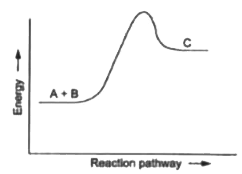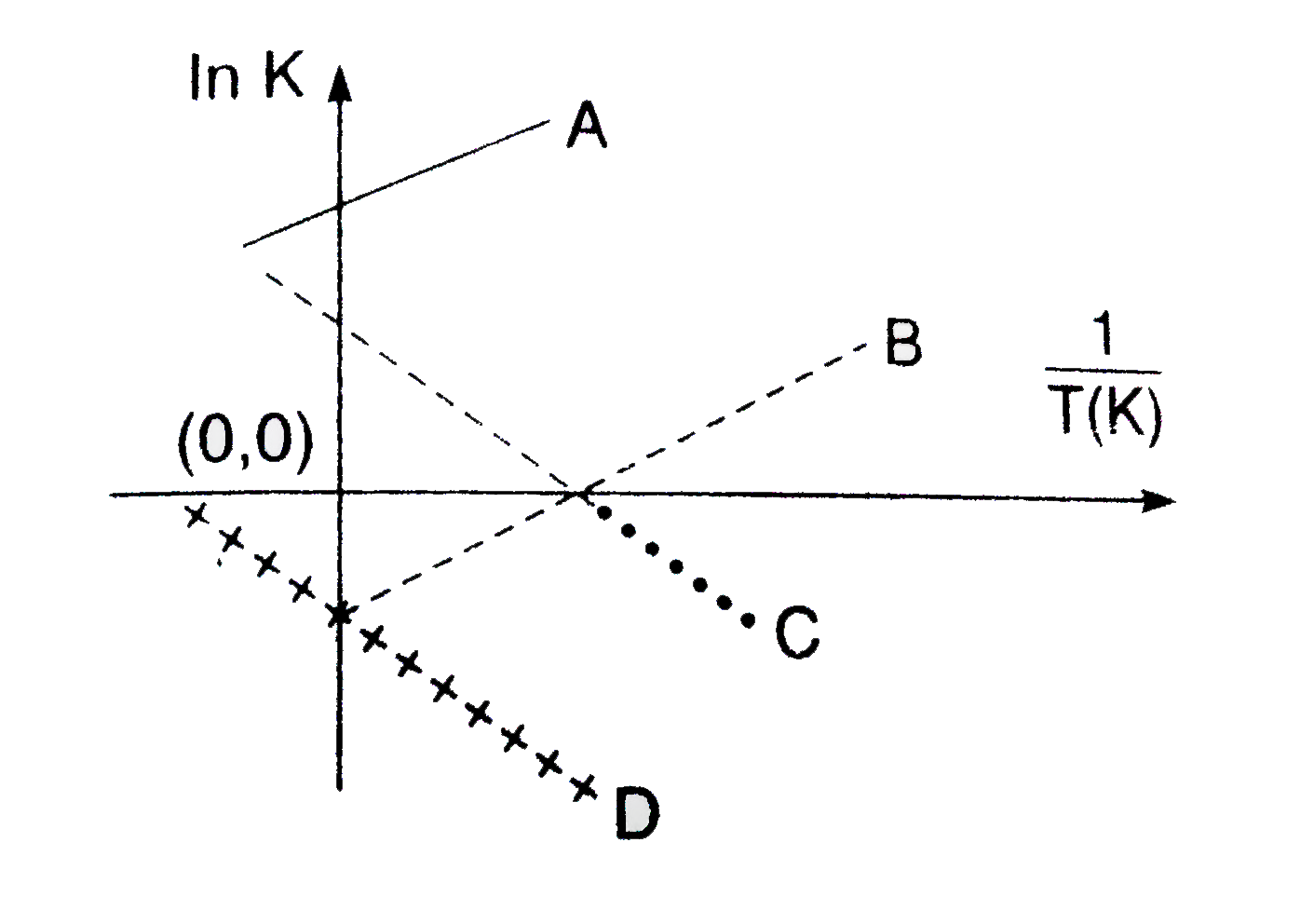Complete Solutions to Objective Problems of chapter CHEMICAL EQUILIBRIUM of Class 12 book with complete answers and questions
| Class 12 | CHEMISTRY |
| Chapter | CHEMICAL EQUILIBRIUM |
| RC MUKHERJEE | Objective Problems |
| Number Of Questions | 57 |
| Academic Year | 2023-24 |
120g of urea is present in 5L of solution, the active mass of urea is
View SolutionFor the equilibrium `A+B Leftrightarrow C+D,` equilibrium constant may be equal to
View SolutionFor which of the following reactions, `K_p` may be equal to 0.5 atm?
View SolutionWhich of the following is correct?
View Solution`K_p//K_c` for the reaction `CO+1/2O_2 Leftrightarrow CO_2` is
View SolutionIf the initial number of moles/L of `N_2, H_2, and NH_3, ` are 1, 2 and 3 respectively, their concentrations at equilibrium will be `N_2+3H_2 Leftrightarrow 2NH_3`
View SolutionA 1-litre container contains 2 moles of `PCI_5` initially. If at equilibrium, `K_c` is found to be 1, the degree of dissociation of `PCI_5` is
View SolutionThe vapour density of undecomposed `N_2O,` is 46. When heated, the vapour density decreases to 24.5 due to its dissociation to `NO_2.` The percentage dissociation of `N_2O_4` at the final temperature is
View SolutionIf the equilibrium constant of the following equilibrium `SO_(2)+1//2O_(2) Leftrightarrow SO_(3) and 2SO_(3) Leftrightarrow 2SO_(2)+O_(2)` are given by `K_1 and K_2` respectively, which of the following relations is correct?
View SolutionFor the reactions `A Leftrightarrow B " "K_c=2 `
`B Leftrightarrow C" "K_(c)=4`
`C Leftrightarrow D " "K_(c )=6`
`K_c` for the reaction `A Leftrightarrow D` is
View SolutionFor the equilibrium `CaCO_3 (s) Leftrightarrow CaO(s)+CO_2(g)` which of the following expression is correct?
View SolutionFor the reaction `C(s) + CO_2(g) Leftrightarrow 2CO(g),` the partial pressures of `CO_2` and Co are respectively 4 and 8 atm. `K_p` for the reaction is
View Solution`K_c" for "A+B Leftrightarrow 3C` is 20 at `25^@C`. If a 2-litre contains 1,2 and 4 moles of A, B and C respectively, the reaction at `25^@C` shall
View Solution`K_(c)` for `A+BhArrC+D` is `10` at `25^(@)C`. If a container contains `1`, `2`, `3`, `4` `mol//litre` of `A`, `B`, `C` and `D` respectively at `25^(@)C`, the reaction shell proceed:
View SolutionA 1-litre vessel contains 2 moles each of gases A, B, C and D at equilibrium. If 1 mole each of A and B are removed, K. for A+B C +D will be
View SolutionTwo samples of HI each of 5 s were taken separately in two vessels of volume 5 and 10 litres respectively at `27^@C.` The extent of dissociation of HI will be
View SolutionFor a reversible reaction if the concentrations of the reactants are doubled, the equilibrium constant will be
View SolutionIf one-third of HI decomposes at a particular temperature, `K_C` for `2HI Leftrightarrow H_2+I_2` is
View Solution28 g of `N_(2)` and 6 g of `H_(2)` were mixed. At equilibrium 17 g `NH_(3)` was produced. The weight of `N_(2)` and `H_(2)` at equilibrium are respectively
View SolutionFor the reaction
`H_(2)(g)+I_(2)(g) hArr 2HI(g)`
The equilibrium constant `K_(p)` changes with
View SolutionThe oxidation of `SO_2" by "O_2" to "SO_3` is an exothermic reaction. The yield of `SO_3` will be maximum if
View SolutionFor the gas phase reaction
`C_(2)H_(4)+H_(2) hArr C_(2)H_(6)(DeltaH=-32.7 "kcal")`
carried out in a vessel, the equilibrium concentration of `C_(2)H_(4)` can be increased by
View SolutionPure ammonia is placed in a vessel at a temperature where its dissociation constant `(alpha)` is appreciable. At equilibrium,
View SolutionAn example of a reversible reaction is
View SolutionWhen `NaNO_3` is heated in a closed vessel, `O_2` is liberated and `NaNO_2` is left behind.
View SolutionThe equilibrium , `SO_2Cl_2(g) hArr SO_2(g)+Cl_(2)(g)` is attained at `25^@C` in a closed container and an inert gas , helium , is introduced. Which of the following statement is are correct ?
View SolutionThe decomposition of `N_(2)O_(4)` to `NO_(2)` is carried out at `280^(@)C` in chloroform. When equilibrium is reached, `0.2` mol of `N_(2)O_(4)` and `2xx10^(-3)` mol of `NO_(2)` are present in a `2L` solution. The equilibrium constant for the reaction
`N_(2)O_(4) hArr 2NO_(2)` is
View SolutionThe equilibrium constants for the reaction `Br_(2)hArr 2Br`
at 500 K and 700 K are `1xx10^(-10)` and `1xx10^(-5)` respectively. The reaction is:
View SolutionWhich oxide of nitrogen is most stable at 273 K?
View SolutionIf a chemical reaction is at equilibrium, which of the following is not correct?
View SolutionIf pressure is applied to the equilibrium of solid-liquid. The melting point of the solid:
View SolutionIf pressure is applied to the following equilibrium, liquid `hArr` vapours the boiling point of liquid
View SolutionFor the equilibrium, `PCl_(5) Leftrightarrow PCl_(3)+Cl_(2), K_(c)=alpha^(2)//(1-alpha)V`, temperature remaining constant
View SolutionWhen `CaCO_3` is heated at a constant temperature in a closed container the pressure due to `CO_2` produced will
View SolutionFor the reaction
`PCl_(5)(g) hArr PCl_(3)(g)+Cl__(2)(g)`
The forward reaction at constant temperature is favoured by
View SolutionWhich of the following curves represents a very rare standard reaction at equilibrium?

View SolutionWhich of the curves given in Q. 36 represents a standard reaction spontaneous in forward direction?
View SolutionWhich of the curves given in Q. 36 represents a standard reaction for which `triangleG^(0) gt 0?`
View SolutionWhich of the curves given in Q. 36 represents a standard reaction with K=1?
View SolutionEach of the mixtures listed below was placed in a closed container and allowed to stand. Which of the following mixtures is not capable of attaining the equilibrium: `CaCO_3(s) Leftrightarrow CaO(s)+CO_2(g)?`
(a) Pure `CaCO_3`
(b) CaO and a pressure of `CO_2` greater than `K_p`
(c) Some `CaCO_3` and a pressure of `CO_2` greater than `K_p`
(d) `CaCO_3` and Co
View SolutionConsider the following equilibrium in a closed container
`N_(2)O_(4)(g)hArr2NO_(2)(g)`
At a fixed temperature, the volume of the reaction container is halved. For this change, which of the following statements hold true regarding the equilibrium constant `(K_(p))` and degree of dissociation `(alpha)`?
View SolutionThe value of the reaction quotient before any reaction occurs is
View SolutionWhat is the minimum mass of `CaCO_3(s)`, below which it decomposes completely, required to establish equilibrium in a 6.50 litre container for the reaction :
`CaCO_3(s)hArr CaO(s)+CO_2(g), K_c=0.05`
View SolutionThe energy profile of the reaction: is shown as `A+B Leftrightarrow C` is shown as,

The equilibrium constant for the said equilibrium
View SolutionNiO is to be reduced to Ni in an industrial process by the use of the reaction
`NiO(s)+CO(g) Leftrightarrow Ni(s)+CO_(2)(g)`
At 1600 K, the equilibrium constant for the reaction is 600. If a CO pressure of 150 mmHg is to be employed in the furnace and the total pressure never exceeds 760 mmHg, will the reduction occur?
(a) Yes (b) No
View SolutionWhich of the following curves between log K and `1/T` is correct?
View SolutionThe thermal dissociation of equilibrium of `CaCo_(3)(s)` is studied under different conditions
`CaCO_(3)(s)hArrCaO(s)+CO_(2)(g)`
For this equilibrium, the correct statement (s) is/are
View SolutionFor the reaction, `SO_(2)(g) + (1)/(2)O_(2)(g)hArrSO_(3) (g)`, If `K_(p) = K_(c) (RT)^(x)` where the symbols have usual meaning then, the value of x is (assuming ideality).
View SolutionThe following reaction is performed at 298 K ?
`2NO(g)+O_(2)(g)hArr2NO_(2)(g)`
The standard free energy of formation of NO(g) is 86.6 kJ/mol at 298 K. What is the standard free energy of formation of `NO_(2)(g)` at 298 K ?
`(K_(p)=1.6xx10^(12))`
View SolutionThe standard Gibbs energy change at `300K` for the reaction `2AhArrB+C` is 2494. `2J`. At a given time, the composition of the reaction mixture is `[A]=1/2, [B]=2` and `[C]=1/2`. The reaction proceeds in the
`(R=8.314JK//"mol"e=2.718)`
View SolutionThe percentage yield of ammonia is a function of time in the reaction `N_(2)(g)+3H_(2) (g) Leftrightarrow 2NH_(3) (g), triangleH lt 0`
at `(p T_(1))` is given below
If this reaction is conducted `(p_(1) T_(1))" with "T_(2) gt T_(1)`, the percentage yeild of ammonia as a function of time is represented by.
View SolutionThe equilibrium constant at `298K` for a reaction, `A+BhArrC+D` is 100. If the initial concentrations of all the four species were 1M each, then equilibirum concentration of `D` (in mol`L^(-1)`) will be
View SolutionThermal decomposition of gaseous X, to X at 298 K takes place according to the following equation
`X_(2) (g) Leftrightarrow 2X(g)`.
The standard reaction Gibbs energy, `triangle_(r)G^@` of this reaction is positive. At the start of the reaction, there is one mole of `X_2` and no X. As the reaction proceeds the number of moles of X formed is given by `beta.` Thus B equilibrium is the number of moles of X formed at equilibrium. The reaction is carried out at a constant total pressure of 2 bar. Consider the gases to behave ideally. (R = 0.083 L bar K'moll) The equilibrium constant K, for this reaction at 298 K in terms of `beta_("eqb")` is
View SolutionThe incorrect statement among the following for this reaction is
View SolutionWhich of the following lines correctly show the temperatrue dependence equilibrium constant,K, for an exotehrmic reaction?

View SolutionAt a certain temperture in a 5L vessel 2 moles of carbon monoxide and 3 moles of chlorine were allowed to reach equilibrium according to the reaction
`CO+CI_(2) rarr COCI_(2)`
at equlibrium if one mole of CO is present then equilibrium constant `(k_(c ))` for the reaction is :
View SolutionIn which of the following reactions, an increase in the volume of the container will favour the formation of products ?
View Solution
Objective Problems questions and complete solutions for chapter CHEMICAL EQUILIBRIUM of BHARATI BHAWAN CHEMISTRY (HINGLISH) of Class 12